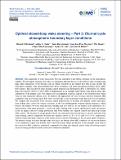Optimal closed-loop wake steering – Part 2: Diurnal cycle atmospheric boundary layer conditions
Author(s)
Howland, Michael F; Ghate, Aditya S; Quesada, Jesús Bas; Pena Martínez, Juan José; Zhong, Wei; Larrañaga, Felipe Palou; Lele, Sanjiva K; Dabiri, John O; ... Show more Show less
DownloadPublished version (7.344Mb)
Publisher with Creative Commons License
Publisher with Creative Commons License
Creative Commons Attribution
Terms of use
Metadata
Show full item recordAbstract
<jats:p>Abstract. The magnitude of wake interactions between individual wind turbines depends on the atmospheric stability.
We investigate strategies for wake loss mitigation through the use of closed-loop wake steering using large eddy simulations of the diurnal cycle, in which variations in the surface heat flux in time modify the atmospheric stability, wind speed and direction, shear, turbulence, and other atmospheric boundary layer (ABL) flow features.
The closed-loop wake steering control methodology developed in Part 1 (Howland et al., 2020c, https://doi.org/10.5194/wes-5-1315-2020) is implemented in an example eight turbine wind farm in large eddy simulations of the diurnal cycle.
The optimal yaw misalignment set points depend on the wind direction, which varies in time during the diurnal cycle.
To improve the application of wake steering control in transient ABL conditions with an evolving mean flow state, we develop a regression-based wind direction forecast method.
We compare the closed-loop wake steering control methodology to baseline yaw-aligned control and open-loop lookup table control for various selections of the yaw misalignment set-point update frequency, which dictates the balance between wind direction tracking and yaw activity.
In our diurnal cycle simulations of a representative wind farm geometry, closed-loop wake steering with set-point optimization under uncertainty results in higher collective energy production than both baseline yaw-aligned control and open-loop lookup table control.
The increase in energy production for the simulated wind farm design for closed- and open-loop wake steering control, compared to baseline yaw-aligned control, is 4.0 %–4.1 % and 3.4 %–3.8 %, respectively, with the range indicating variations in the energy increase results depending on the set-point update frequency.
The primary energy increases through wake steering occur during stable ABL conditions in our present diurnal cycle simulations.
Open-loop lookup table control decreases energy production in the example wind farm in the convective ABL conditions simulated, compared to baseline yaw-aligned control, while closed-loop control increases energy production in the convective conditions simulated.
</jats:p>
Date issued
2022Department
Massachusetts Institute of Technology. Department of Civil and Environmental EngineeringJournal
Wind Energy Science
Publisher
Copernicus GmbH
Citation
Howland, Michael F, Ghate, Aditya S, Quesada, Jesús Bas, Pena Martínez, Juan José, Zhong, Wei et al. 2022. "Optimal closed-loop wake steering – Part 2: Diurnal cycle atmospheric boundary layer conditions." Wind Energy Science, 7 (1).
Version: Final published version